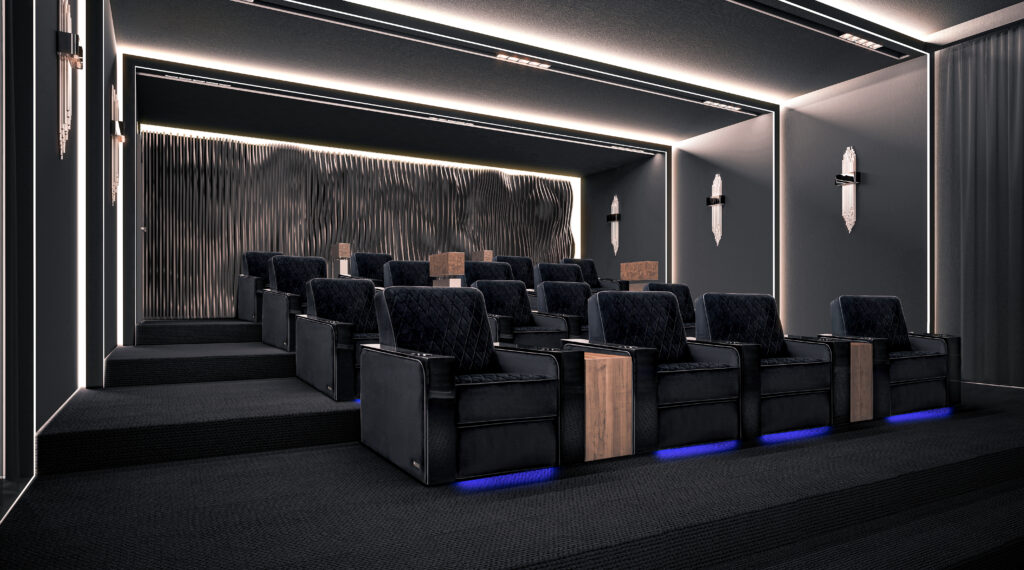
The possibility of having your very own home theater sounds amazing. And with today’s online stores for multimedia seating, you can even build a home theater room yourself. But where do you start?
We know all about designing your own home theater room; our customers often share their DIY movie room endeavors with us. And we’ve learned that planning is often the most important part of a home theater build; the seating design and audiovisual tech are just a couple pieces of the whole picture.
But before any planning happens, think about your ideal home theater room: how big it is, how many people can be in it at once, the finishes you might want… then write this all down. Some pre-planning brainstorming on your movie room’s layout, tech, seating, accessories, etc., will give you some direction. Then you can hit the ground running on your planning and design phase by hashing out each of these factors:
- Budget wisely.
Create a budget for your home theater project, and break it down by expense. For example, you might want to invest more in a screen, and get more modest audio equipment. A narrow room will need different audiovisual specs than a basement movie room or a big entertainment room. Which aspects of this space are most important to you? This should give you a better idea of what you will be spending for each item, and more or less what your total cost will be.
- Choose the dimensions.
This only applies if you’re building your home theater as an addition. If you already have a room you’d like to turn into a movie room, this step will only involve measuring that room and making some calculations as to how many people can comfortably fit in it. Regardless, think how many people you’d like to be seated, as well as the room for extras like a minibar, an aisle or anything else.
But this step isn’t just about the dimensions of the room; you’ve got a lot of math to do. Rows of theater seats need to fall within the ideal section of the visual cone from the projector screen, and this requires analysis of distance and angles. Choosing curved rows of seating can make this step a bit simpler, as they give better angles to the seats at the ends of the rows.
As well, room dimensions and seating layout will determine what the best sound system setup is. Do you want rows of theater recliners on elevated risers, a giant entertainment room sectional with multimedia features, or anything in between? Don’t forget to factor in outlet placement and any in-wall wiring. We get into detail with these factors in our comprehensive home theater seating guide.
- Pick your equipment.
This is where you get all the goodies. Considering your budget and what part of the viewing experience is your priority, choose audiovisual equipment that is good quality while fitting your budget. From a screen to the speakers and the electrical outlets, think about all the specification you want before making any purchase.
Quality projectors, screens and sound systems are widely available now. From curved flat screen TVs to 4K projectors to compact sound bars with booming bass, you’ll likely have more options than you know what to do with. Often, you can find experts in your area that will counsel you on what brands might be better for your needs and the space you have.
- Choose the seating.
Forget that old, lumpy couch; if you’re already building a private theater room, go all in and get some real theater seats. And not the kind you see in your local cinema; theater seats can be much more comfortable than those. Pick a model that offers support and is stylish at the same time, whether you want to go traditional, quirky, plush, or modern.
Once you’ve chosen your desired multimedia seating, you can customize almost everything about it. Lumbar support, powered headrests, seat upholstery like leather, microfiber and velour available in over a dozen colors – you will be amazed at the amount of options available! Our customers overwhelmingly recommend our bass shaker seat feature.
- Design the inside of your room.
This is where you can really express your style and taste. Whether you want a modern room, or would rather enjoy a traditional vibe, the world is your oyster! There are definitely some must-haves, like sound and light control, but even those are customizable, too. For instance, long, heavy velvet curtains can both dampen sound and black out sources of light intrusion. Acoustic panels can add dynamic texture to your walls while also optimizing your sound system.
When it comes to paint color, darker is better for dedicated theater rooms. And don’t forget the ceiling! Then there are all the possibilities for accessories in your home theater, like a mini fridge, wine caddies, a popcorn machine, and anything else you’d love for convenience or just for fun!
- Go for it!
Now that you have everything planned out and the equipment selected, it’s time to go all in and do it. Whether you want to do it yourself or would rather have an expert do the dirty work instead, all of this will make setting up your home theater as easy as it can get!
